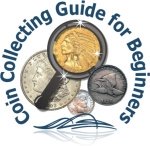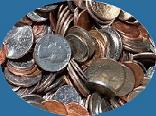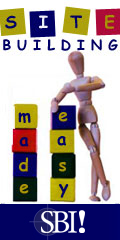Coin Collecting Terms and
Coin Collecting Definitions
Used by Coin Collectors

Coin collecting terminology seems to be a language of it's own. This coin collecting glossary of terms and their definitions will speed you on your way to becoming a professional numismatist in no time.
When you are new to coin collecting, and you begin to visit coin shows or join a coin club, you will start to hear some words that may be very unfamiliar to you. Listed here are a lot of coin collecting definitions and terminology that are used commonly by coin collectors to describe things such as coin minting or grading or some other aspect of coin collecting. You will want to familiarize yourself with these coin collecting terms so that you will know what other collectors and dealers are talking about.
I have tried to include most of the most common coin collecting terms in this glossary for your reference. You will also find some coin collecting terms that might not be extremely common but that you may run across when you are reading an old coin book.
This glossary of coin collecting terms will help you understand coin terms with brief, easy to read definitions.
As you read through the glossary you will probably find that you would like more information on a lot of these coin collecting terms. I will be providing more and more pages as time goes by that will discuss these coin collecting terms in more detail. I will try to include links next to each specific coin collecting term to the page on which you can find more information about that particular coin collecting term.
Glossary of Coin Collecting Terms Begins Here
These coin collecting terms are listed in alphabetical order. You can click the letter to jump to the coin collecting definitions beginning with that letter or just scroll down to browse them all.
A
Adjustment Marks
These are some file marks that show up on some early coins. The blanks for these coins were filed down before the coin was struck to get them to the proper weight and these file marks were still visible after the minting process.
Alloy
A mixture of two or more metals.
Altered
Sometimes coins are changed in an attempt to defraud collectors. Examples would be artificial toning, changing mint marks, changing dates and whizzing. These changes are usually easily spotted with the aid of a magnifying glass.
Anepigraphic coin
Coin without an inscription.
Annealing
Process of heating blank planchets to soften the metal before minting.
Artificial Toning
This is another attempt at fraud where someone tries to enhance a coins color or look with extreme heat/cold or chemicals. It is usually a dark brown or bluish color and often looks spotty. Natural Toning occurs as a coin ages but it usually doesn't stand out. It usually blends into the coin's surface.
Assay
Test to ascertain the weight and purity of a coin.
Attribution
This is anything on a coin that can be used for identification purposes such as date, mint mark, or denomination.
Back To Top of Coin Collecting Glossary
Coin Collecting Terms beginning with the letter B
B
Bag Mark
When coins are first minted they are placed in cloth bags for delivery to banks etc. As the bags are moved around the coins inside rub against each other causing surface marks and scratches.
Base metal
Non-precious metal or alloy containing no gold or silver.
Basining
The process of polishing the face of a die.
Beading
Raised dot border along the rim of a coin.
Billon
Low-grade alloy of gold or silver with a high percentage of another metal, usually copper.
Bi-metallic
A coin with one type of metal in the center with an outer ring of a different metal, such as the Canadian "toonie" two-dollar coin.
Blank
Prepared disk of metal on which the coin design will be stamped. First the disk is cut from large rolls of metal. These are Type I Blanks. Then they are milled to put a slight rim on the edge. These are Type II Blanks. Then these blanks, also called a planchet, are stamped into a coin.
Body Bag
If a coin is sent to a Third Party Grading Service and they determine that it has such a significant problem that they will not encapsulate the coin, the coin is returned to the collector/dealer in a plastic polyvinyl bag. This bag has come to be known by the slang term
body bag.
Brass
Copper based alloy with zinc.
Brockage
A coin that has been struck in a die that still has an existing coin in it. The brockage coin will have an inverted impression of the original coin on one side.
Bronze
Copper based alloy with tin.
Bullion
Precious metals (platinum, gold and silver) in the form of bars, ingots or plate, or where quantity is considered as a valuation.
Burnishing
The process of polishing blank planchets. This is usually only done for proof coinage.
Business Strike
A coin intended for everyday use in commerce.
Back To Top of Coin Collecting Definitions
Coin Collecting Terms beginning with the letter C
C
Cameo
This is a coin that has a large amount of contrast between the portrait or devices and the field. Usually the fields of these coins have a deep mirror look. Cameos can be on proof or uncirculated coins.
Carat
Unit of measure for precious stones. 1 carat = 200 milligrams. 'Karat' is the term used with gold.
Certified Coin
Coin that has been graded and authenticated by one of the third party grading services.
Read more here....
Circulated
A term used to describe a coin that has wear.
Clad Coinage
Coins that have a center core of one metal and an outer layer of a different metal.
Collar
A part of the die chamber that holds the blank in place while it is being stamped.
Commemorative
This is a coin that is issued for a special event or maybe to honor an outstanding person.
Read more here....
Contact Marks
Minor scratches and abrasions on uncirculated coins from being in contact or rubbing against other coins.
Counterfeit
Any coin that is not made by the authorized minting authority.
Countermark or Counterstamp
Letters, symbols, numbers or other marks that are stamped on a coin after minting. They could be used for special advertising or political slogans etc.
Cud
A raised place on a coin caused by a die having a piece broken off.
Back To Top of Coin Collecting Glossary
Coin Collecting Terms beginning with the letter D
D
Debase
To lower the silver/gold value of the coin by altering its purity, but with the same market value as the pure coin.
Denticles
Small tooth like raised points on the inside edge of coins.
Design
A particular motif on a coin or other numismatic item such as Seated Liberty, Morgan, or Barber.
Design Type A particular motif used on a coin that may be used for several denominations and subtypes.
Designer Artist or creator of a coin's design.
Details
Small features and fine lines in a coin design, such as seen in feathers, hair, leaves, and wreaths.
Device
Pattern or emblem used in the design of a coin.
Die
Metal piece engraved with the design used for stamping the coin.
Die Clash
Caused when the two dies 'clash' together because a planchet failed to enter the die during the minting process. This can cause parts of the design of one or both of the dies to be impressed into the opposite die. When this happens, subsequent coins minted with the damaged dies will have a 'shadow' of the opposite die. It can also result in die cracks or defects.
Die Crack
Fine raised line on a coin that was caused by a crack in the die.
Die Defect
This refers to various sorts of defects caused by a damaged die. It could be a die crack or die clash etc., as mentioned above.
Die Variety
Minor alteration in the basic design of a coin throughout its lifespan.
Dipped, Dipping
This refers to chemically cleaning a coin with a diluted acid. It used to be common practice until it was discovered that it destroyed the surface of the coin and reduced the coin's value.
Double Eagle (U.S.A)
United States gold $20 coin.
Read more here.....
double strike
This is where a die struck the coin, then bounced and struck again, a little offset from first strike.
Double Die
This is a coin that shows numbers or letters doubled. It is caused when the coin die was made with a doubled design on parts of it.
Doubloon
Popular name of a Spanish gold coin originally valued at 4 dollars.
Back To Top of Coin Collecting Definitions
Coin Collecting Terms beginning with the letter E
E
Eagle (U.S.A)
United States $10.00 gold coin.
Read more here.....
Edge
This is the rim of a coin. It can contain a series of reeds, lettering or other decoration. It could also be plain.
Also see
Coin Terms - Anatomy of a Coin
Effigy
The image or likeness of a person, usually on the obverse of a coin or medal.
Elongated coin
A small oval token or medal that is made by squeezing a coin, usually a penny, through a roller die.
Encapsulated Coins
These are coins that have been authenticated, graded and preserved in plastic by an independent service.
Engraver
This is the person who cuts the image of a design onto a die.
Error
This is a coin that acquires some sort of defect during production. For some reason the mistake wasn't caught by inspectors at the mint.
Exergue
This is a portion of the coin design separated by a line that usually indicates the ground in the design. This is where a legend is placed.
Eye Appeal
Just how it sounds. This is your first impression of a coin whether good or bad. Eye appeal is one of the primary determinants of grade.
Back To Top of Coin Collecting Definitions
Coin Collecting Terms beginning with the letter F
F
Field
Background area of a coin not used for a design or inscription.
Also see
Coin Terms - Anatomy of a Coin
Filler
This is a coin that is very worn but it is rare enough for collectors to include in their collection until they find a coin in better condition.
Fineness
This describes the purity of gold or silver. It is usually expressed in the terms of one thousand parts.
Flan
Blank metal piece before striking, also called a planchet or blank.
Back To Top of Coin Collecting Glossary
Coin Collecting Terms beginning with the letter G
G
Gem
This is a coin of exceptionally high condition.
Grade
This is the condition of a coin or amount of wear that a coin has received. Read more about
grading here.....
Gripped Edge
This is as a series of tiny indentations, or grip marks around the circumference of the coin.
Also see
Coin Terms - Anatomy of a Coin
Back To Top of Coin Collecting Definitions
Coin Collecting Terms beginning with the letter H
H
Hairlines
Minute lines on coins caused by light cleaning, polishing or light contact with plastic flips or plastic slides, typically on proof coins .
Half Eagle
A United States five dollar gold coin.
Read more here....
Hub
A metal object with the intended coin design in relief on one end as it would appear on the finished coin. It is used to produce dies.
Back To Top of Coin Collecting Definitions
Coin Collecting Terms beginning with the letter I
I
Incuse
Part of the coins design that has been impressed below the surface. When the design of the coin is cut into the coin instead of raised up. When the design is raised up above the coin's surface, it is said to be in relief.
Ingot
This is a bar molded of pure metal (usually precious metals) in a certain purity.
Inscription
Lettering and wording on a coin.
Intrinsic Value
Current market value of the raw precious metal content of a coin.
Back To Top of Coin Collecting Definitions
Coin Collecting Terms beginning with the letter K
K
Karat
Unit of measure for the purity of gold. 24K is pure gold, whereas 18K = .750 fine. 'Carat' is the term used with precious stones (see above).
Key Coin
Rarest or highest valued coin within a series.
Key Date
This is a slang term used to indicate the rarest date and mint mark of a particular coin series.
Back To Top of Coin Collecting Glossary
Coin Collecting Terms beginning with the letter L
L
Laureate
Head crowned with a laurel wreath.
Legal Tender
Coins or currency which must be accepted in payment of debt.
Legend
Principle inscription on a coin.
Also see
Coin Terms - Anatomy of a Coin
Lettered Edge
The outside edge of a coin containing an inscription.
Also see
Coin Terms - Anatomy of a Coin
lg.
This is an abbreviation for the word "large". In
coin collecting terms if usually refers to a date or mint mark.
Low Relief
A coin with the raised design not very high above the field.
Luster
This is the glossy, shiny appearance of a coin or the coin's ability to reflect light; brilliance.
Back To Top of Coin Collecting Definitions
Coin Collecting Terms beginning with the letter M
M
Master die
The main die produced from the master hub. Many working hubs are prepared from this single die.
Milled Edge
Raised rim around the outer surface of a coin.
Mint Error
Defective coin produced by a mint.
Mint Luster
Shiny "frost" on the surface of an uncirculated or mint coin.
Mint Mark
Small letter (or other symbol) indicating which mint the coin was struck at. Read more about
Mint Marks here.....
Also see
Coin Terms - Anatomy of a Coin
Mint Roll
Uncirculated coins wrapped by the issuing mint of a certain quantity.
Mint Set
Set of uncirculated coins packaged and sold by the mint. Read more about
Mint Sets here.....
Mis-strike
Off center striking of a coin.
Motto
Inspirational phrase or wording. Examples include "In God we Trust" on US coins or "Liberte, Egalite, Fraternite" on French coins.
Also see
Coin Terms - Anatomy of a Coin
Mule
This is a coin that was struck from two dies not intended to be used together. For example, it would have the front (obverse) of one denomination and the back (reverse) of another denomination. These are very rare.
Multiple Strike
This is a coin that has been struck more than one time as the coin moved slightly. It is not the same as a double die.
Back To Top of Coin Collecting Glossary
Coin Collecting Terms beginning with the letter N
N
NCLT - Non Circulating Legal Tender
This is coins that can be legally used as money but are not actually intended for circulation. Some examples are commemorative coins, old coins, or rare coins.
Nick
A small mark on a coin caused by another coin bumping against it or by contact with a rough or sharp object.
Numismatics
The scientific study of currency and its history in all its varied forms.
Numismatist
A specialist in numismatics. A person who collects numismatic items, especially coins.
Back To Top of Coin Collecting Definitions
Coin Collecting Terms beginning with the letter O
O
Obverse
Front or face side of coin.
Also see
Coin Terms - Anatomy of a Coin
Off-Center
This is a coin that has been struck when not centered in the press. Both sides of the coin will have the same blank area.
Overdate
This is a coin that has a numeral or two from a different year in it. This usually occurred if the mint was trying to use a working hub from the previous year. An example would be the 1943/2 Jefferson Nickel.
Over Graded
Coin in worse condition than stated.
Over Mintmark
This is similar to an Overdate except that the mint mark is stamped twice into the coin (d/d). Another possibility is one mint using another mint's hub which created an over mint mark with two different mint marks. Example 1900 O/CC.
Overstrike
Impression with new dies on a previously struck coin.
Oxidation
This is when oxides or tarnish form on the surface of a coin. It is caused by exposure to dampness, industrial fumes, other elements, or even air.
Back To Top of Coin Collecting Glossary
Coin Collecting Terms beginning with the letter P
P
Pattern
This term when used in coin collecting describes a prototype of a proposed coin design.
Patina
Surface film caused by oxidation mostly found on older silver, copper or bronze coins. It is usually green or brown.
Pedigree
Record of previous owners of a rare coin.
Planchet
Blank prepared piece of metal on which the coin is struck. Read more about
how coins are made here.....
Planchet Defect
A defect on the planchet. It could be from a piece of metal or dirt in the die or a problem with the original planchet that was fed into the die.
Portrait
The portrait is usually on the obverse of the coin, and it can be a person, or an image.
Also see
Coin Terms - Anatomy of a Coin
Press
This is the machine used to produce the actual coin. It can be a machine press, screw press or hammer press. Read more about
how coins are made here.....
Privy
Small mark, often hidden, on a coin, traditionally to indicate the mint master or moneyer. Read more about
privy marks here.....
Proof
Coins specially struck for collectors using polished dies and planchets.
Read more here....
Proof Set
Set of proof coins packaged and sold by the mint.
Read more here....
Prototype
This is a pattern coin which is identical to the coins later adopted for general use. They are usually dated the year prior to the general use coin.
Back To Top of Coin Collecting Definitions
Coin Collecting Terms beginning with the letter Q
Q
Quarter (U.S.A./Canada)
United States or Canada $0.25 coin. Short for Quarter Dollar.
Read more here....
Quarter Eagle (U.S.A)
United States $2.50 coin.
Back To Top of Coin Collecting Glossary
Coin Collecting Terms beginning with the letter R
R
Raw
This is a coin that has not been encapsulated by any coin grading service.
Reeded Edge
The edge of a coin with grooved lines around the perimeter. It is also known as a milled edge.
Also see
Coin Terms - Anatomy of a Coin
Relief
This is any part of the coin's design that is raised above the coin's surface.
Also see
Coin Terms - Anatomy of a Coin
Re-strike
This is a coin that is produced from genuine dies but at a date later than the original issue.
Reverse
Back side of the coin. Opposite of 'Obverse'.
Also see
Coin Terms - Anatomy of a Coin
Rim
Raised portion of the design along the edge that protects the coin from wear.
Also see
Coin Terms - Anatomy of a Coin
Round
Round one ounce silver bullion piece.
Read more here....
Back To Top of Coin Collecting Definitions
Coin Collecting Terms beginning with the letter S
S
Scratch
A deep line or groove in a coin caused by contact with a sharp or rough object.
Seignorage
The difference between the cost of producing a coin and the actual face value of that coin. It is the profit the mint makes on a coin, so to speak.
Series
Set of years coin was minted with a specific design and denomination.
Slab
Plastic case containing a coin that has been graded and encapsulated by a third party grading service.
Read more here....
sm.
This is an abbreviation for the word "small". In
coin collecting terms it usually refers to a date or mint mark.
Spanish dollar
Coin issued in Spain and its colonies from 1497 to 1864. Equal to 8 Reals. Also known as a 'Piece of Eight'.
Spot Price
Quoted market value of precious metals in bullion form.
Stainless Steel
A combination of iron, carbon and another element, usually nickel, to prevent rusting.
Striations
Thin, light raised lines on the surface of a coin, caused by excessive polishing of the die.
Striking
This refers to the process by which a coin is minted. It could also refer to the sharpness of design details. For example, a sharp or strong strike will show all of the details struck very sharply, but a weak strike will show details lightly. Read more about
how coins are made here.....
Strip
A rolled piece of metal that the blank planchets are cut from.
Back To Top of Coin Collecting Glossary
Coin Collecting Terms beginning with the letter T
T
Token
These are privately-issued coin like pieces that usually have a redeemable value for goods or services. They are not an official government coin.
Toning
This is a natural discoloration of a coin's surface caused by the atmosphere over a long period of time. Toning can be very attractive. Some collectors prefer to collect coins with this feature.
Toned Coin
A coin that has some coloring that it did not have from the mint. It can be any color. Some toned coins are very beautiful, others are not. Toning can have an effect on the overall value of the coin.
Trade Dollar
Silver dollar issued specifically for trade with a foreign country.
Trial Strike
This is a coin that was struck while trying to adjust the pressure of the dies. It is usually a very weak strike.
Truncation
Sharply cut off bottom edge of a portrait or bust.
Type
The basic distinguishing design of a coin.
Type Set
One of each coin of a particular design, series or period.
Back To Top of Coin Collecting Definitions
Coin Collecting Terms beginning with the letter U
U
Uncirculated
This is a coin that has never been in circulation and retains its original luster. It is also called a Mint State coin.
Uniface
A coin struck with the design on one side only.
Unique
This is a coin of which only one is known to exist.
Upset
This is a coin struck that has the obverse and reverse are at different angles to each other.
Back To Top of Coin Collecting Glossary
Coin Collecting Terms beginning with the letter V
V
Variety
A variation in the design of a particular coin. Some dates have several die varieties.
Back To Top of Coin Collecting Definitions
Coin Collecting Terms beginning with the letter W
W
Weak Strike
This is a coin that has certain areas of its details not fully formed. It can be caused by the hardness of metal, insufficient striking pressure or improper die spacing.
Whizzing
This is the process of trying to make a coin appear to be a higher grade by polishing it.
Working Hub
This is also called a hub. It ismade from a master die and is used to make working dies.
Working Die
This is a die that is made from a working hub. These are the dies which produce the actual coins.
Back To Top of Coin Collecting Glossary
Coin Collecting Terms beginning with the letter Y
Y
Year Set
Set of coins for any specific year containing one of each denomination of that year.
Back To Top
I hope this glossary of
coin collecting terminology has helped you understand these terms and definitions a lot better. I know it is a lot to take in all at once, but don't get discouraged. You can come back to the
Coin Collecting Terms page at any time. A good idea would be to bookmark it and come back and learn a few new
coin collecting terms each day.
What Would You Like To Do Now?







